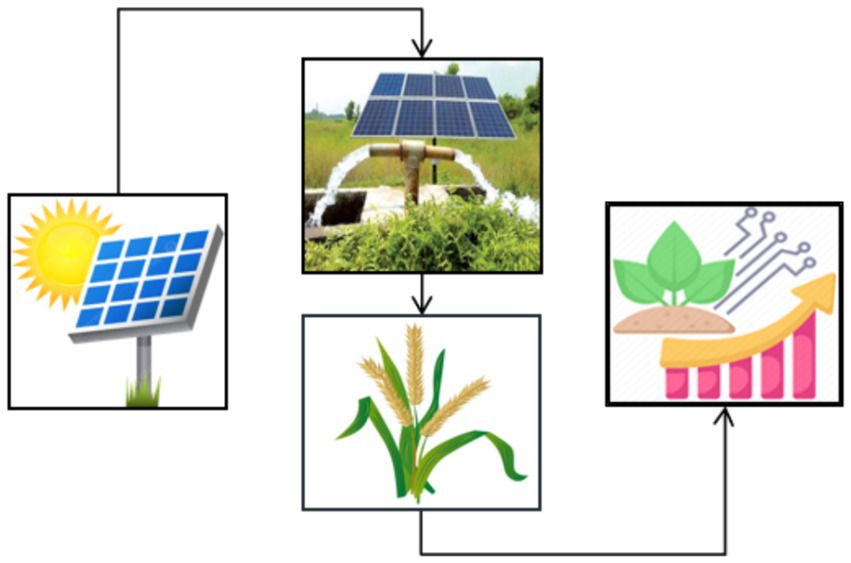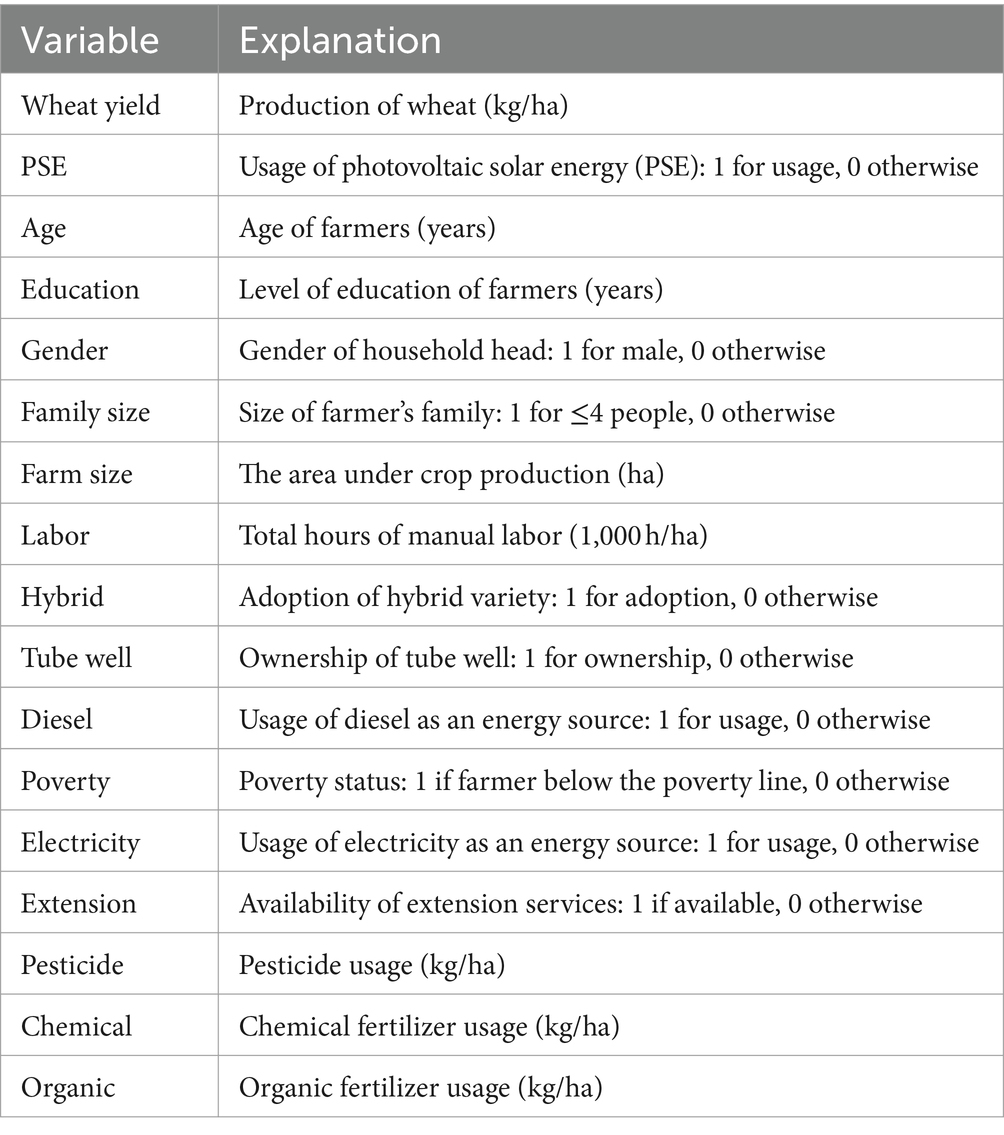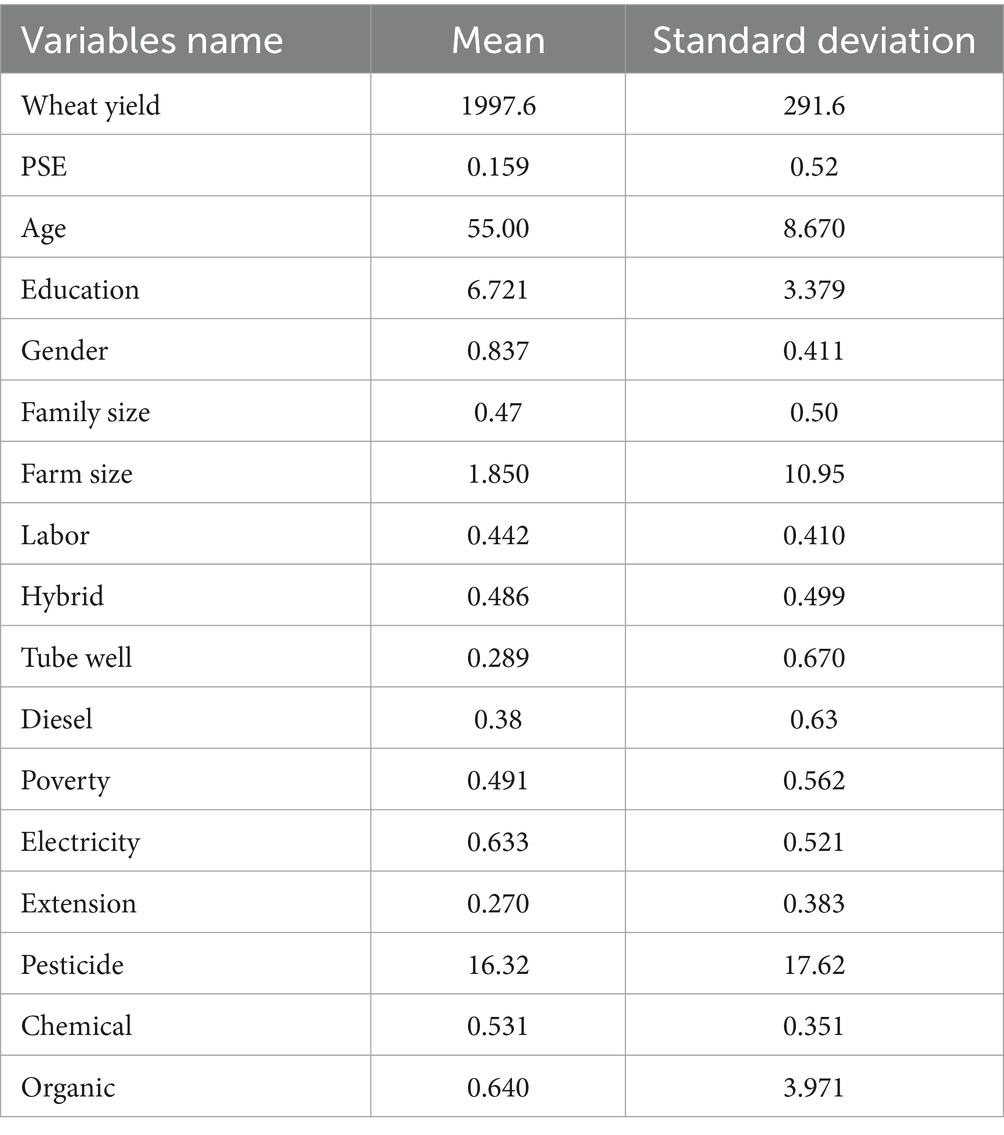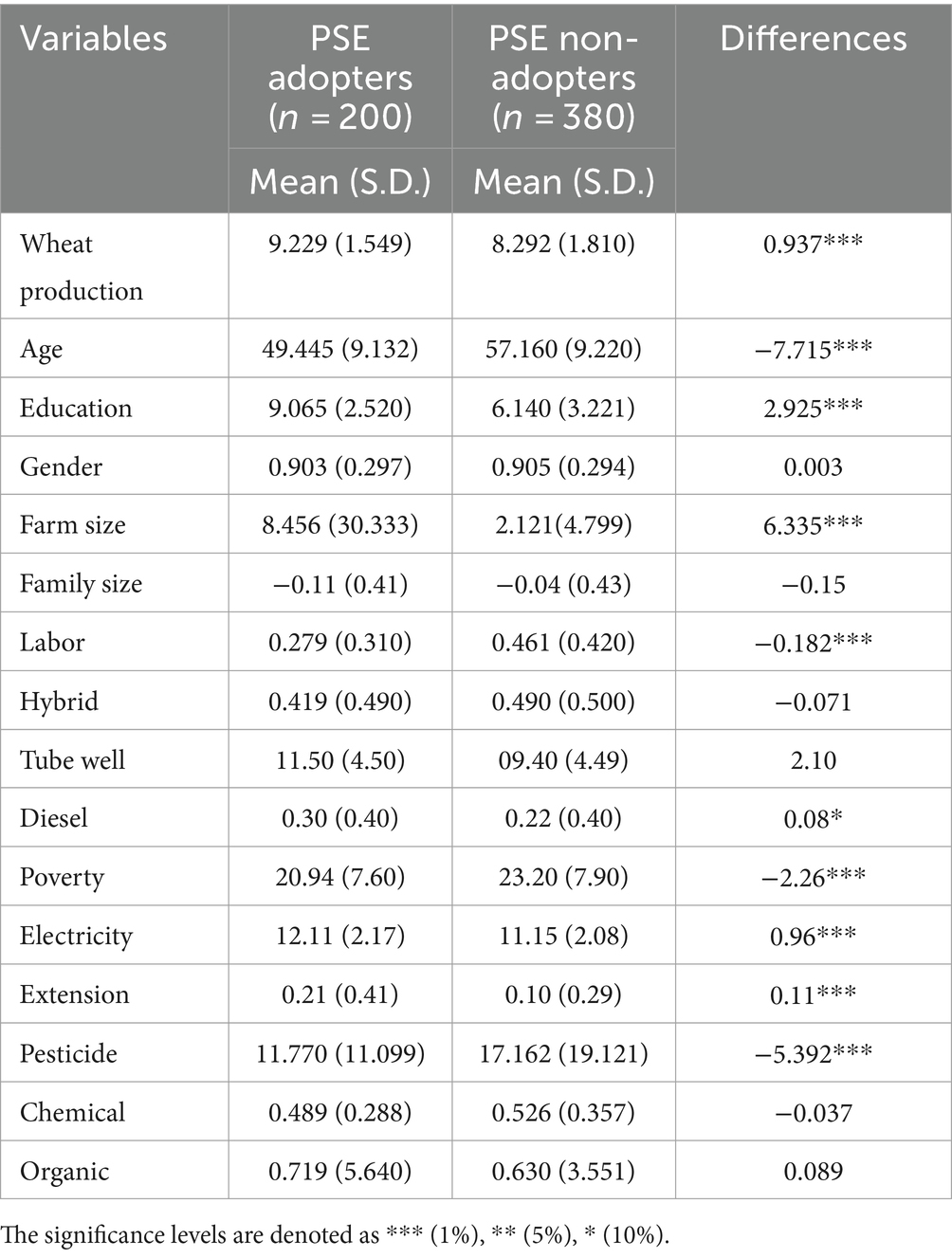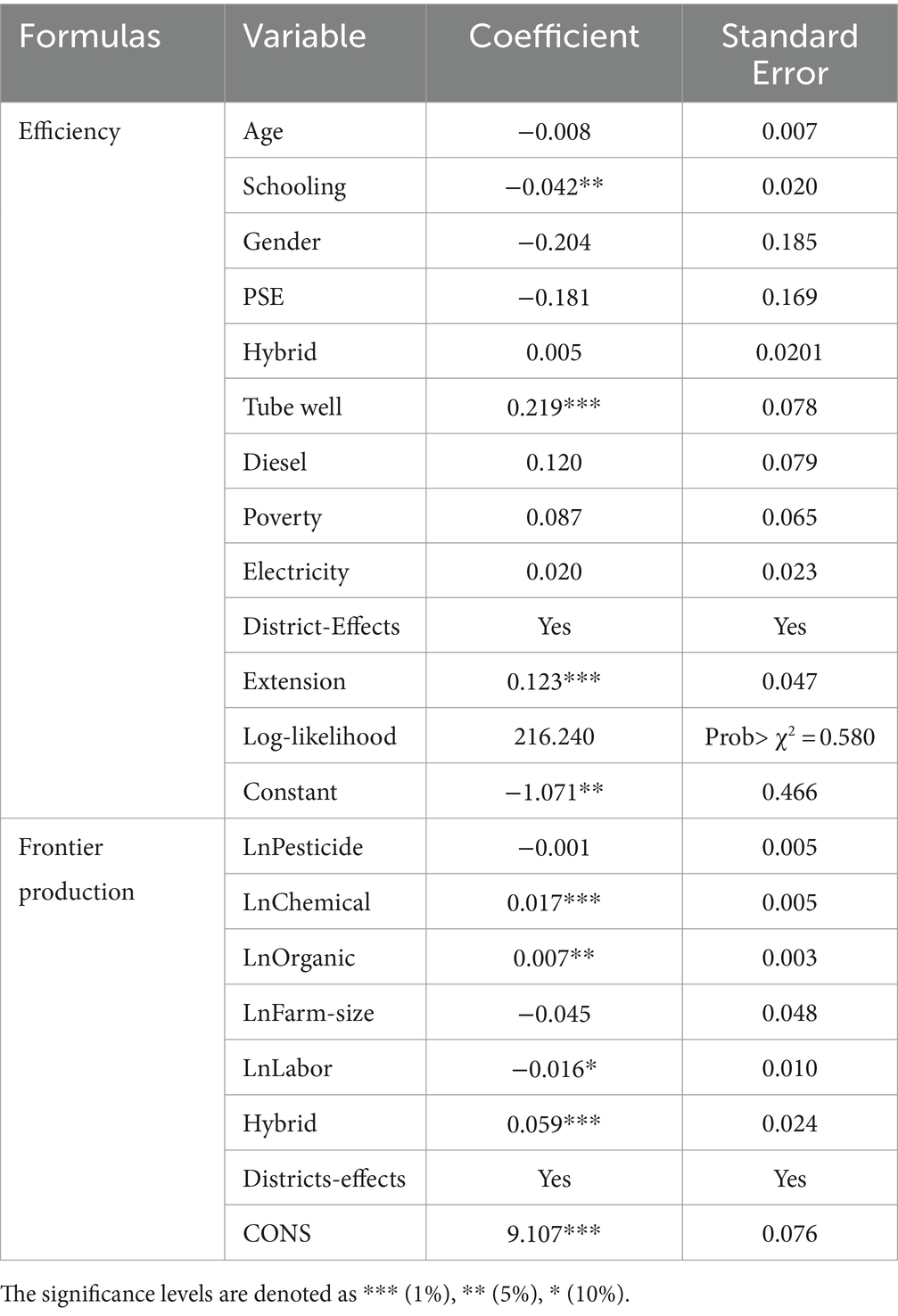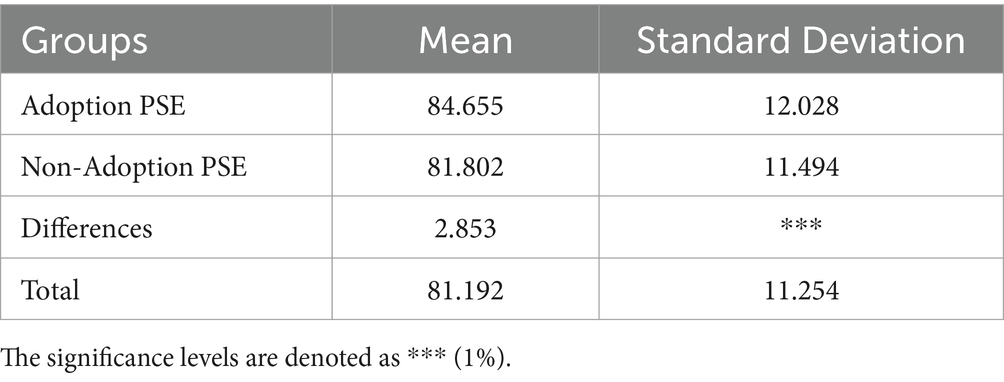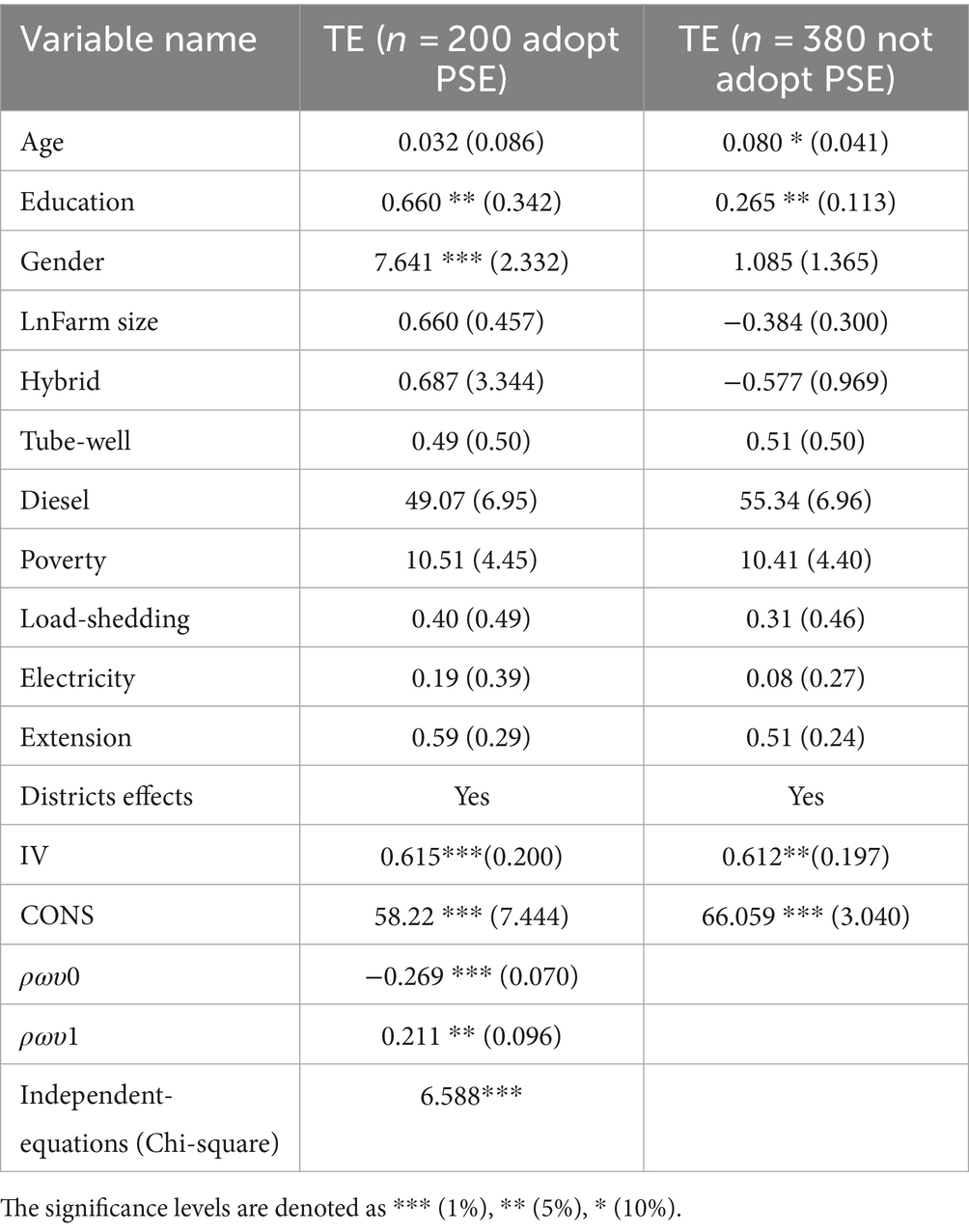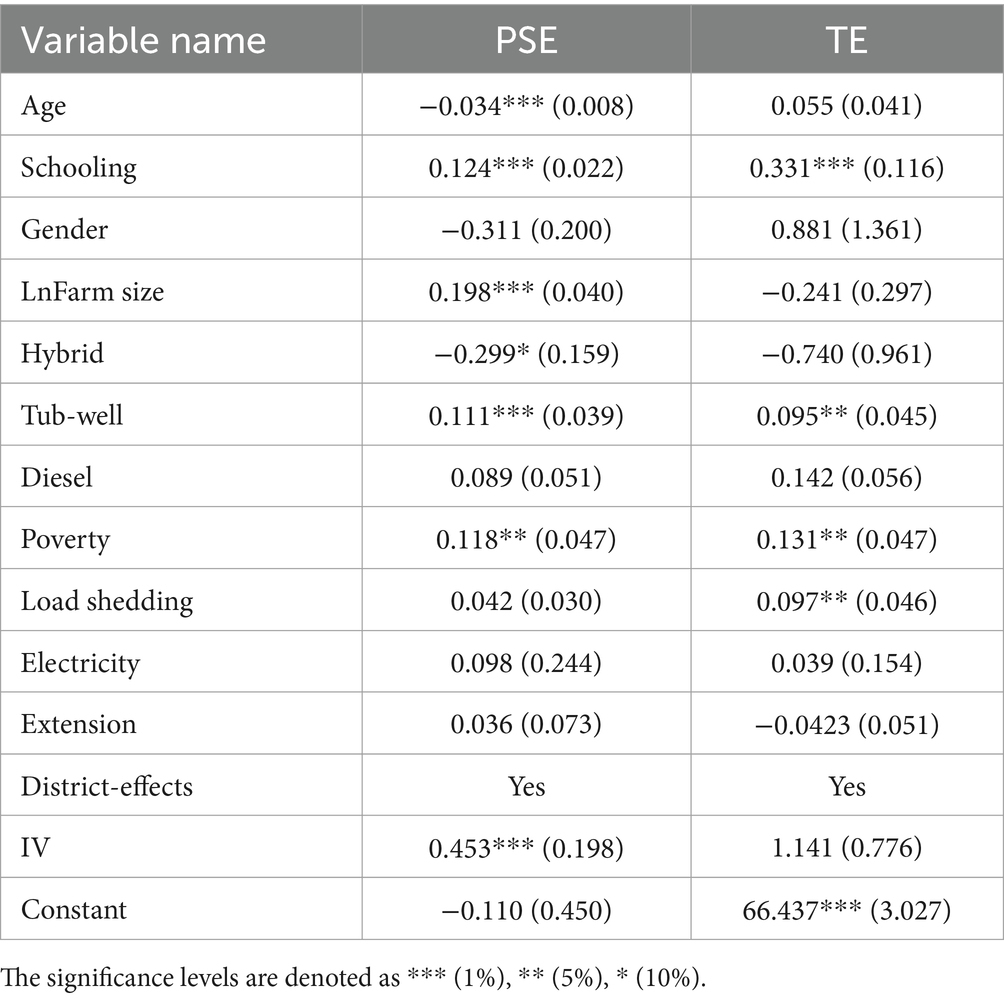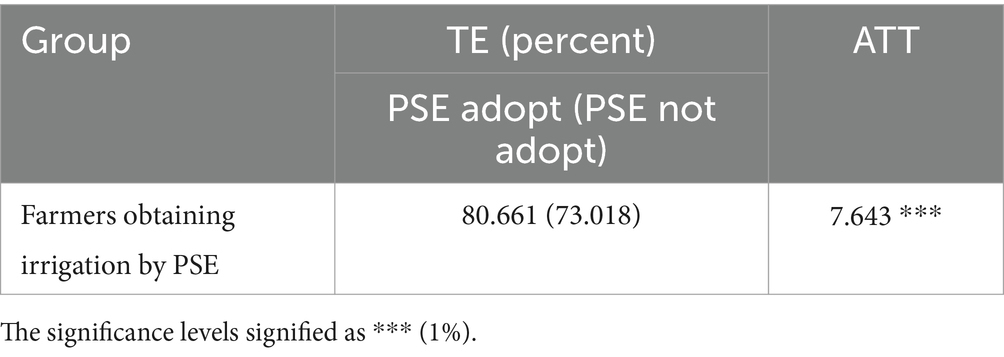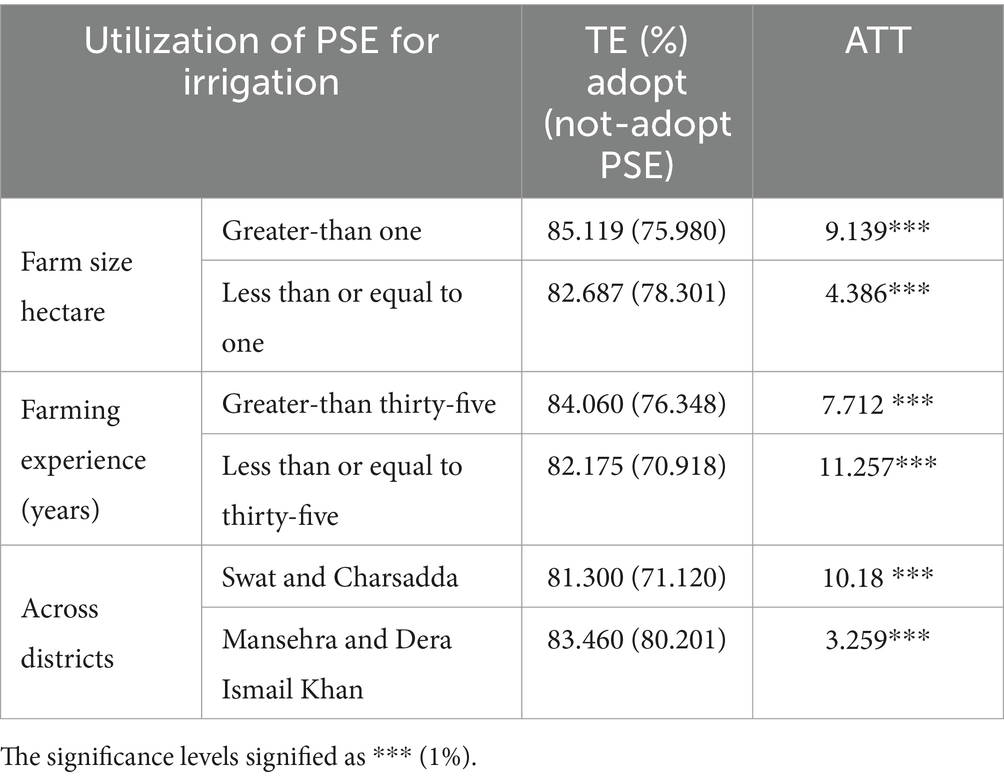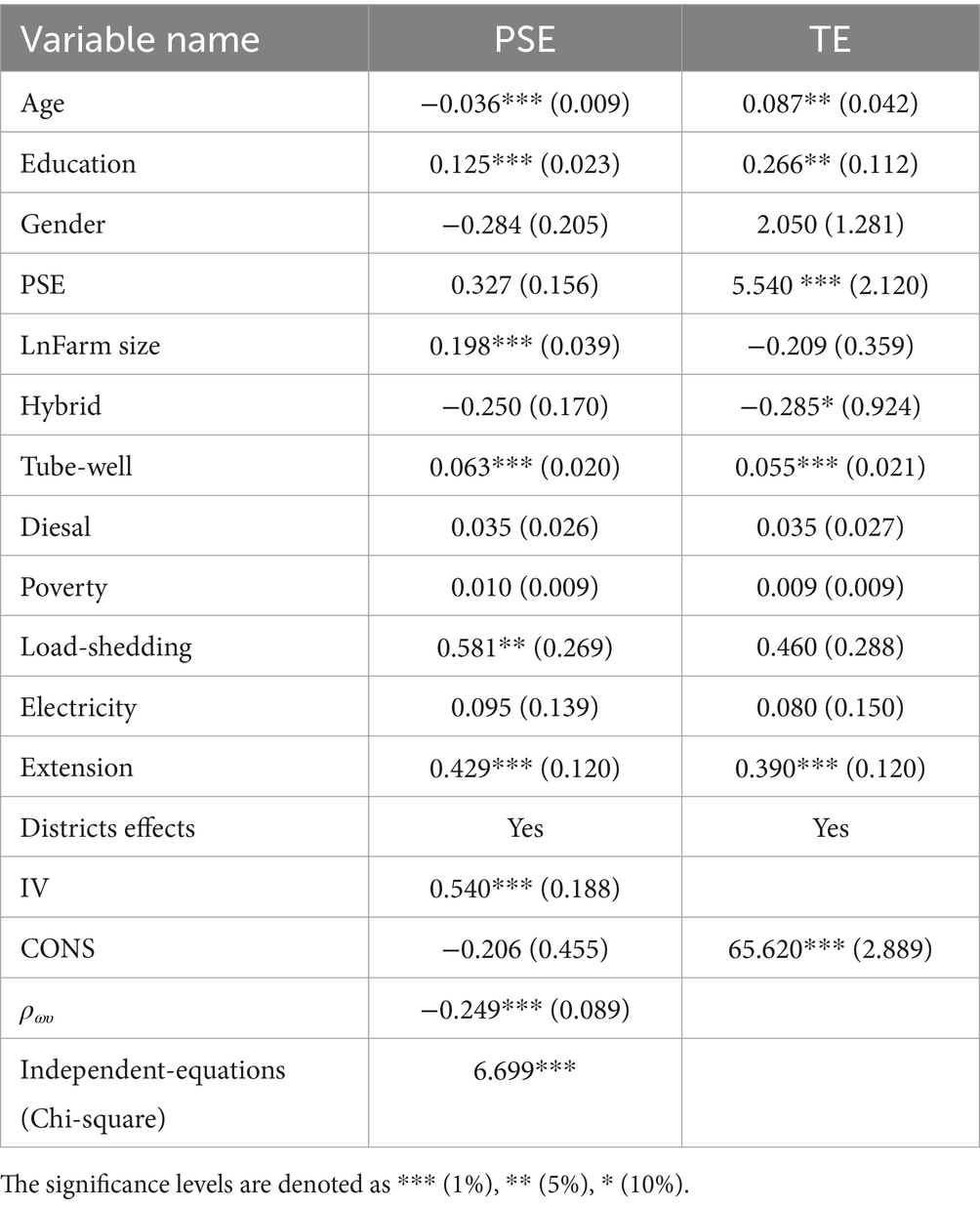- 1College of Economics and Management, Shandong Agricultural University, Tai’an, China
- 2College of Public Administration, Shandong Agricultural University, Tai’an, China
- 3College of Management, Sichuan Agricultural University, Chengdu, China
Persistent electricity shortages in Pakistan, causing prolonged grid power load shedding, have adversely impacted various sectors, notably agriculture and the livelihoods of rural farmers. Literature suggests that adopting photovoltaic solar energy can mitigate these issues. This research aims to measure the impact of photovoltaic solar energy on the technical efficiency of food productivity in Khyber Pakhtunkhwa, Pakistan, applying data from 580 respondents. Addressing self-selective bias through ESR and stochastic frontier production function model is utilized to assess technical efficiency. The findings of this study reveal that farmers using solar energy experience a significant improvement in technical efficiency, with 15.8 percent of them achieving a 7.643 percent increase, after accounting for self-selection bias. Furthermore, the positive effects are more pronounced among larger farms and those with greater farming experience. This study underscores the importance of evidence-based approaches in implementing solar energy solutions, highlighting their potential to foster sustainability and equitable development at the grassroots level. The research culminates with policy recommendations that underscore the importance of promoting the photovoltaic solar energy use among farmers to improve food security and increase agricultural productivity.
1 Introduction
The utilization of photovoltaic solar energy (PSE) technology stands out as a distinctive innovation within the realm of renewable energy technologies (RETs). Acknowledged as a clean energy source, PSE offers a notable advantage by reducing greenhouse gas emissions compared to non-renewable fossil fuel-based energy. The global appeal of PSE-based power generation technology has surged in recent years, becoming a focal point for economies aiming to enhance their energy portfolios and embrace green development practices (Ahmar et al., 2022). This technology serves as an expedient and viable solution, particularly in off-grid or under-electrified areas, enabling entities to produce and self-consume electricity with minimal maintenance (Palm, 2017; Khan et al., 2021a). At the household level, PSE systems have not only contributed to the rising prominence of RETs but have also facilitated their integration into the “energy ladder.” In the context of advancing agricultural production, a critical focus on technical efficiency (TE) is imperative. In the face of a worldwide energy dilemma marked by an increasing dependence on finite resources, the pursuit of sustainable alternatives emerges as imperative (Sunny et al., 2023). The pervasive utilization of fossil fuels has aggravated carbon emissions and led to progressively centralized food systems and energy infrastructures, making them susceptible to disruptions. Current challenges such as heatwaves, prolonged droughts, and the socioeconomic fallout from the COVID-19 pandemic have significantly impacted agricultural systems, potentially heightening the risk of food crises and driving up global food and energy costs (Khan et al., 2021b; Ben Hassen and El Bilali, 2022; Khayyam et al., 2022; Sunny et al., 2023). In South Asia specially in Pakistan, where predominantly agricultural societies heavily depend on pump irrigation fuelled by groundwater, the adoption of energy-efficient technologies becomes imperative for resilience and sustainability.
The energy-irrigation relationship in South Asia, particularly evident in Pakistan’s farming industry, is intimately linked with the region’s extensive use of groundwater. South Asia’s position as the largest consumer of groundwater worldwide, with an annual extraction of nearly 210 cubic kilometers, underscores the importance of this association (Mukherji and Shah, 2005; Ali and Behera, 2016). The extraction of groundwater not only influences agricultural yield but also has far-reaching consequences for family income and poverty reduction. In the context of Pakistan, where the energy system is a vital basis for irrigation, the reliance on high-efficiency methods and tube well irrigation further intensifies the connection between energy and agriculture (Khan et al., 2024). Unfortunately, the prevalent use of costly and environmentally detrimental sources like petroleum and coal for energy needs in irrigation contributes to greenhouse gas emissions. In Pakistan, where agricultural systems reliance on subterranean water ranks third globally, the situation is striking. Approximately 73 percent of its land area is sustained by the extraction of a staggering 60 billion m3 of groundwater annually (Shahid et al., 2017). The substantial presence of over 1.2 million tube wells, largely powered by diesel (84%) and electricity (16%), accentuates the importance of the energy-irrigation relationship, with the majority concentrated in the Punjab province of Pakistan (Hussain et al., 2023).
Despite Pakistan’s ample solar irradiation, estimated at around three thousand sunny hours per year, with levels ranging from 5 to 7 kWh/m2, the acceptance of PSE has been sluggish (Jahangiri et al., 2020). Specific information reveals a considerable PSE power potential, ranging from 1,200 to 2,100 kWh/kWp annually. Pakistan’s expensive terrain and bountiful solar ray coverage unveil a remarkable solar system potential, eclipsing current electricity demands by more than fivefold, as highlighted by the National Renewable Energy Laboratory (Rafique et al., 2020). With the capability to unleash over (10,000) gigawatt-hours (GWh) of solar power, solar energy is a beacon of reliability for remote and off-grid locales, thereby illuminating pathways to enhanced electricity accessibility (Shah et al., 2019). Notably, Pakistan could feasibly satisfy its present electricity needs by harnessing a mere 0.071% of its land for PSE, revealing a treasure trove of untapped promise (Tahir et al., 2018; Ullah et al., 2023). However, despite these promising signs, the acceptance and implementation of PSE in Pakistan have been slow, hindering the realization of solar energy benefits for the agriculture sector, households, and businesses (Hassan et al., 2018). The gradual pace in embracing solar solutions highlights the need for accelerated efforts to unlock Pakistan’s solar potential, offering sustainable solutions that align with broader objectives related to agricultural productivity and energy resilience in the region.
In Pakistan’s agricultural economy, a reliable energy supply is imperative for fostering growth, enhancing employment opportunities, and improving incomes for the rural area population. Factually, hydroelectric and thermal power have formed the core of Pakistan’s energy base. However, severe power outages, stemming from significant supply gaps and burgeoning energy demand in industrial and agricultural sectors, have created a critical energy disparity that hampers economic progress (Sandilah and Yasin, 2011; Asif, 2012; Rafique and Rehman, 2017). The energy disparity has resulted in increased power costs, significantly impacting the accessibility of reasonable and adequate energy for most of Pakistan’s rural inhabitants. Given that more than 60.3 percent of the nation’s 180 million people live in rural parts and count on agriculture, the sector’s significant contribution to the national gross domestic product (GDP), employment, and exports underscores its crucial position in the economy.
Recognizing Pakistan’s climatic advantages that allow efficient cultivation of various crops, including maize, rice, and wheat, underscores the importance of securing a reliable and consistent energy supply for the agriculture sector (Ali and Behera, 2016; Finance, M.O, 2021). Despite being self-sufficient in wheat production, the demand for secure food supplies and poverty reduction necessitates the successful cultivation of crops like rice and maize (Ali et al., 2017). The association between irrigation systems and energy is paramount, impacting the overall success of these sectors. An inadequate and inconsistent energy supply poses a threat to agricultural potentials and rural livelihoods.
Severe energy shortages in Pakistan, resulting in frequent power outages and escalating electricity prices, have adversely affected farmers who rely on pumped irrigation. The shortage of both energy and water poses challenges to the effective application of agricultural inputs, with profound effects on agricultural production and food security. In response to these challenges, farmers are increasingly turning to alternative energy sources for water pumping, transitioning from electrically powered systems to those driven by diesel, solar, and biogas.
This shift not only expands the options available to farmers for irrigating their crops but also presents a more cost-effective and pragmatic alternative in contrast to electricity-driven pumps. With conventional energy sources becoming progressively more costly and scarce, there exists a substantial opportunity to harness energy from sustainable sources for irrigation in rural Pakistan (Bhutto et al., 2012; Ali and Behera, 2016; Abbas et al., 2017). Biogas, windmill pumps, and PSE systems can, to a certain extent, replace conventional fuel and power in the water pumping sector. In regions where grid energy is either insufficient or unavailable, solar system pumping emerges as a viable substitute to fulfill agricultural and potable water requirements (Arab et al., 1999; Belaud et al., 2020; Raza et al., 2022). The potential for water pumping technology based on renewable energy sources holds significant promise in Pakistan, given its heavy dependence on groundwater for agriculture, the existence of remote communities without grid access, and an average of approximately 300 sunny days per year (Aziz and Abdulaziz, 2010; Tariq et al., 2021; Raza et al., 2022). However, the extensive acceptance of environmentally friendly water pumping techniques hinges on their financial feasibility and environmental benefits (Purohit, 2007; Ali and Behera, 2016). Understanding the factors influencing the uptake and usage of water-pumping technology in Pakistan necessitates considering the knowledge, demographics, and socio-economic backgrounds of the farmers involved. The existing study aims to explore the utilization of PSE systems and evaluate their influence on technical efficiency in crop production.
This article is structured as follows: it commences with the introduction, Section two presents the methodology. Results and discussions are presented in section three. The final parts concludes, highlighting implications and study limitations.
2 Literature review
Many studies have highlighted the benefits of adopting PSE-based irrigation systems over traditional irrigation systems. For example, studies conducted in the United States and Spain have shown that solar water pumping systems are more cost-effective for rural farmers, providing high performance, reliability and customer satisfaction while being environmentally sustainable for agricultural irrigation (Arias-Navarro et al., 1871; García et al., 2019; Sunny et al., 2023). In northern Benin, a study found that farmers using commercial-scale solar drip irrigation systems achieved significantly higher agricultural yields compared to farmers using traditional methods (Alaofè et al., 2016). Similarly, in China, the use of solar water pumping systems increased feed productivity, met local demand, and reduced carbon emissions (Luo et al., 1895; Campana et al., 2017). These findings highlight the economic, environmental, and productivity advantages of PSE-based irrigation systems. Not only provide farmers with a cost-effective and reliable solution, but also contribute to sustainable farming practices by reducing their carbon footprint. The improvements in yields and resource efficiency observed across different regions further support the viability of solar irrigation systems as a superior alternative to conventional irrigation methods. Therefore, wider adoption of PSE-based systems can play a vital role in promoting sustainable agriculture and addressing the challenges faced by farmers in different environmental contexts.
In the Philippines, an analysis of the impact of PSE shows that these systems not only reduce greenhouse gas emissions by up to 26.5 tons of CO2e/ha/year, but also contribute to significant energy savings ranging from 11.4 to 378.5 liters per hectare of diesel per year, the average return on investment is 315% (Guno and Agaton, 2022). However, in Pakistan, the adoption PSE significantly reduced operating costs, increased farmers’ income, reduced CO2 emissions by 17,622 tons per year, and saved 41% of water consumption (Raza et al., 2022). In addition to irrigation and power generation, the PSE addresses drinking water needs in water-scarce areas and promotes gender empowerment by reducing the labor-intensive demands of diesel systems, allowing women to participate in more productive activities (IRENA, 2016; Agrawal and Jain, 2019). A study on PSE adoption in Bangladesh shows that when economic returns are considered in terms of internal rate of return (IRR), the most profitable approach is to establish a small SIF (20%), followed by a large SIF (10%).
Conversely, small PSEs have the highest net environmental benefit per kilowatt peak (kWp) of 86,000, followed by medium PSEs with 67,184 kWp and large PSEs with 65,392 kWp (Islam and Hossain, 2022). Furthermore, research shows that PSE adopters can reduce irrigation costs by up to 2.22%, have a return on investment (ROI) that is 4.48 to 8.16% higher than non-adopters, and reduce total production costs by almost 1% (Sunny et al., 2022). Although the initial investment of PSE is higher than that of diesel powertrains, lower maintenance and zero fuel costs make PSE a more economical option in the long run (Rana et al., 2021). Overall, switching to PSE-based irrigation systems has many advantages, ranging from economic benefits and increased agricultural productivity to environmental sustainability and social impact. These systems have proven to be a viable alternative to traditional irrigation methods, especially in rural and water-scarce areas. This study aims to address research gaps by providing fresh insights into the impact of PSE-based irrigation on the TE of wheat production in Pakistan. It also examines the variability in these effects across different farm sizes and levels of farming experience. The study’s contributions to the literature are threefold. First, it specifically investigates how PSE irrigation influences TE in wheat production, offering more relevant policy implications for enhancing food security through PSE development. Second, it delves into the heterogeneity of these effects, considering both farm size and farming experience. Third, the study tackles the self-selectivity issue in farmers’ decisions to use PSE irrigation, ensuring unbiased estimation results.
3 Materials and methods
3.1 Study area description
Khyber Pakhtunkhwa (KP) province is located in northwestern Pakistan, covering an area of almost 101,741 square kilometers. Its terrain is varied, from rugged mountains to fertile valleys. KP provides significantly to Pakistan’s economy, particularly in agriculture, with its fertile plains and valleys growing a variety of crops (Khan et al., 2022a). While many areas of the province offer favorable conditions for agricultural activities, several challenges prevent it from reaching its full potential. Farmers across the province are generally worried, with more than 81% of farmers expressing concern about issues such as power and water shortages, which have adverse effects on agricultural productivity (Ashraf and Routray, 2013). In the administrative structure of Pakistan, provinces are the highest level of governance and each province has its provincial government. Districts serve as secondary administrative divisions within the province, and Tekes serve as subdivisional administrative units within the districts. Union Council (UC) represents the smallest administrative unit within a tehsil.
3.2 Data collection and variables selection
3.2.1 Data collection
The research conducted from July 2023 to December 2023 focused on the KP province in Pakistan. Data collection involved distributing 580 questionnaires to wheat farmers, employing multistage random sampling techniques. The aim was to investigate the impact of PSE on wheat production efficiency. The study progressed through seven stages: firstly, Pakistan was selected, followed by KP becoming the primary study area in the second stage. Subsequently, study data were categorized into four districts based on agricultural production proportions in the third stage. The fourth stage entailed selecting ten tehsils from the four districts to administer a predetermined questionnaire. Twenty UCs were then chosen from tehsils in the fifth stage. The sixth phase involved randomly monitoring twenty villages from these UCs, engaging a total of 580 farmers in the seventh stage (Figure 1). The questionnaire was initially created in English and then translated into Urdu to suit the needs of the farmers. We collected data from wheat growers through interviews and questionnaires. Given the complexity of the questionnaire, in-depth interviews were conducted. To eliminate ambiguities, a pretest was conducted. The survey included detailed information on farmers’ socio-economic characteristics, PSE and other related variables. The illustrative size of the sample was determined utilizing a sample size computation equation adopted by Yamane (1973), which is considered ideal for the same population. The Equation (1) and the resulting number of samples are provided below:
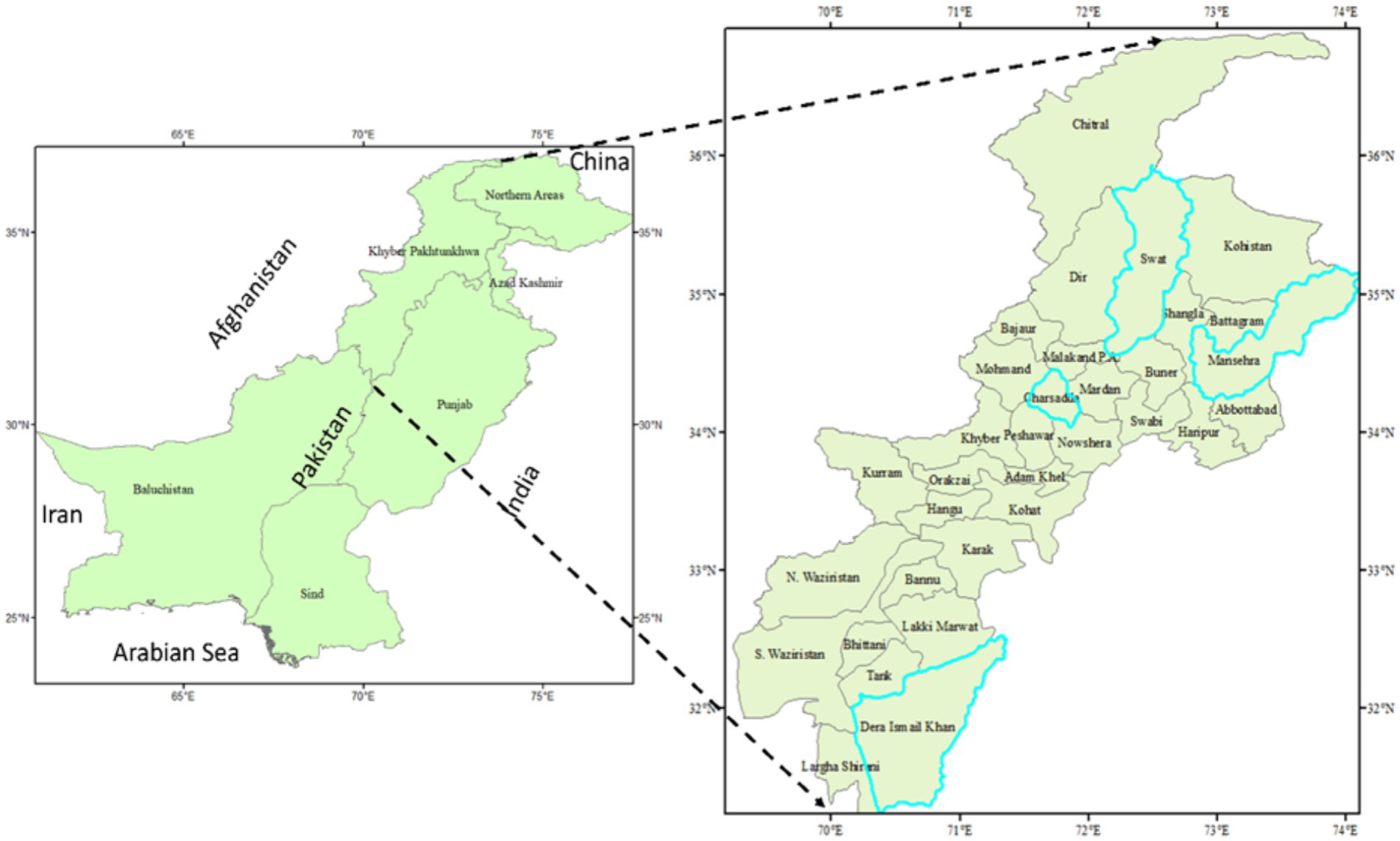
Figure 1. Map of the study area (Khan et al., 2022b,c).
Where: n is the needed example size; N = size of the population or total number of rural households living in the study areas; e = precision level which is assumed to be 5%, as standard.
3.2.2 Variables selection
The study focused on estimating the dependent variable, TE in crop production, utilizing a stochastic frontier production function (SFPF). Key inputs for this function comprised organic, chemical fertilizers, pesticide use, cost of agricultural machinery, and manual labor per hectare, with crop yield serving as the output metric. The primary independent variable of attention was binary, distinguishing whether a farmer utilized irrigation for crop production sourced from a PSE (Table 1). To address potential endogeneity concerns, an instrumental variable approach was adopted. Specifically, a dummy variable was introduced to denote whether a farmer’s neighbors employed PSE-based irrigation for crop production. This instrument was chosen based on the premise, as suggested by prior research, that there exists a peer effect influencing farmers’ technology adoption decisions (Khan et al., 2022d). Thus, it was proposed that a farmer may be more likely to embrace PSE-based irrigation if neighboring farmers adopted it. Consequently, the instrumental variable was deemed very associated with a grower’s choice about the adoption of PSE-based irrigation. Furthermore, as the neighbors’ irrigation method choice was assumed not to directly impact the focal farmer’s crop production efficiency but rather correlated with their adoption of similar irrigation methods, it was considered a valid instrumental variable. Thus, the presence of neighboring farmers utilizing PSE-based irrigation was posited to serve as a credible instrument for the focal farmer’s adoption of such irrigation methods.
3.3 Empirical approaches
The existing research adopted a multifaceted three-step evaluation strategy. Initially, we quantified the TE in wheat production using a SFPF model. Following this, we employed an endogenous switching regression (ESR) technique to analyze the determinants influencing farmers’ choices regarding the adoption of irrigation, with a specific emphasis on PSE. This phase also investigated the influence of PSE and other variables on TE concerning wheat production and the diversity in irrigation practices. Additionally, instrumental variable (IV) validation was carried out in this phase. Lastly, we conducted rigorous robustness tests and investigated heterogeneity to ensure a thorough assessment.
3.3.1 Stochastic frontier production function model
TE computation employed the SFPF model, chosen over data envelopment analysis due to its ability to accommodate random elements like extreme weather occurrences. In Equation (2) the development of the SFPF model adhered to the following:
where the output Qi is modeled as a product of the function Q(Xi; α) and the exponential of the difference between the random error factor (vi) and nonnegative efficiency factor (ui). This formulation allows for the inclusion of both deterministic factors (captured by the function Q(Xi; α)) and stochastic factors (captured by the random error term vi) in the modeling of wheat output for the i-th farmer. The efficiency factor ui reflects the efficiency level of the farmer in converting inputs into wheat output (Chen et al., 2022). The TE of wheat production can be computed by applying the following Equation (3): Where Effi symbolizes the TE of the i-th farmer. It is imperative to note that TE values for farmers range from zero to hundred percent.
3.3.2 Endogenous switching regression technique
It is essential to recognize that the farmers’ choice to employ PSE for irrigation systems may lead to a form of self-selection, potentially introducing bias into the analysis. To mitigate this self-selection bias, previous studies have commonly employed the ESR technique, comprising one treatment and two outcome equations (Di Falco et al., 2011; Azmi, 2015; Huang et al., 2015; Zhang et al., 2021). In current research, a stochastic utility framework has been applied to investigate growers’ decisions regarding the adoption of PSE for wheat crop irrigation. The Equation (4) suggests that signifies the disparity in utility among crop irrigated by PSE and those irrigated by alternative technologies. When > 0, farmers are inclined to choose PSE for crop irrigation, while when ≤ 0, farmers are less likely to opt for PSE. Consequently, the decision of growers to adopt PSE for crop irrigation can be expressed as:
Here, represents a binary variable, taking the value of one if the farmers opt for irrigation through PSE and zero else. encompasses factors influencing growers’ decisions to utilize PSE for grain irrigation, with β representing the coefficients to be determined, and indicating the random error with a mean of zero. As well, as irrigation from PSE, various other factors contribute to TE. Therefore, two outcome Equations (5), (6) have been formulated (Chen et al., 2022):
In this context, the binary variable 1 denotes farmers adopting PSE for crop irrigation, while 0 signifies those who do not. The efficiency in wheat production for farmers utilizing PSE and those not utilizing it is represented by and , correspondingly (Ullah et al., 2023). accounts for exogenous variables influencing efficiency and the estimated coefficients are denoted by δ1 and δ0. Additionally, υ1i and υ0i are random error terms with mean values of 0.
Given the presence of inherent self-selection bias, the computed mean TE values in both real-world and hypothetical situations for wheat growers employing PSE to irrigate their crops are as follows in Equation (7):
In this context, represents the covariance between ωi and v1, while denotes the covariance between ωi and υ0i. The term is defined as φ (Tiβ)/Φ(Tiβ), representing the inverse Mills ratio. It is essential to highlight that φ(•) denotes the standard normal probability density function, and Φ(•) denotes the cumulative distribution function of the standard normal distribution (Chen et al., 2022). The ATT, which signifies the disparity between the estimated average TE of crop production under both authentic and counterfactual conditions among cultivators applying PSE for crop irrigation, is calculated in Equation (8) as:
Representing the standard deviations of ωi, v1i, and v0i by , , and συ0, respectively, we can express correlation coefficient between ωi & υ1i as ρωυ1 = σωυ1/(σωσυ1), and the correlation coefficient between ωi and υ0i as ρωυ0 = σωυ0/(σωσυ0). Noteworthy self-selectivity bias is indicated by significant ρωυ1 and ρωυ0 values. To compute the ESR model, it is essential to incorporate at least one IV, denoted as Ti and excluded from Zi. This IV should be linked to farmers’ decisions to adopt PSE for irrigation but should not be associated with TE unless influenced by PSE. The estimation of the ESR method in the current research uses the FIML method (Zhang et al., 2021; Zhu et al., 2021).
4 Results and discussions
4.1 Descriptive statistics
Table 2 provides crucial variables, illustrating that 15.8% of participants utilize PSE. Most household heads in the sample (85%) are male, with an average age of approximately 55 years and an average schooling level of around seven years. Notably, only 29% of farmers possess tube wells, signifying a thriving ground-water market in the research area, where 70% rely on borrowed water for irrigation. In the context of common challenges faced in rural areas, load shedding exceeds, significantly limiting activities that rely on modern inputs and adversely impacting crop production. The research reveals that a projected 49% of farmers are surviving below in poverty line. In terms of energy bases, electricity is the preferred choice for several growers, followed by diesel and PSE. On average, the grown land per family is 1.85 ha, and wheat yield stands at 1997.6 kg/ha. These findings underscore the complex socio-economic and environmental factors influencing agricultural practices and livelihoods in rural Pakistan, underlining the essential for targeted interventions to address challenges and enhance sustainable development.
4.2 Analyzing contrasts: PSE impact on farmers’ practices and characteristics
Variances between wheat farmers utilizing PSE for wheat productivity and those who do not are presented in Table 3. The comparison reveals significant variations across various aspects between these two growers groups. Those employing PSE irrigation exhibit higher wheat yields, reduced herbicide usage, increased agricultural machinery adoption, and lower dependence on human labor compared to non-PSE users. However, there are no substantial differences observed in the use of organic and chemical fertilizers among the two growers’ categories. PSE irrigated growers tend to be younger, possess higher levels of education, and own more extensive crop farmhouses in terms of both individual and plantation characteristics. These notable distinctions may indicate the presence of self-selection bias. Overall, these findings highlight the importance of PSE in enhancing agricultural outcomes and the need for targeted interventions to promote its adoption among a broader range of farmers.
4.3 Estimation of technical efficiency
The SFPF method was employed to approximate the Cobb–Douglas and translog specifications, as detailed in Table 4. An essential step in identifying the optimal description involved conducting a likelihood ratio test. The χ2 statistic, with a value of 216.240, did not reach statistical significance (Prob>2 = 0.580). This outcome indicates the translog design of Cobb–Douglas SFPF is nested within it. To SFPF method, 1 % enhance in the cost of technology, chemical, and organic fertilizer results in enhancements of crop yield by (0.003%), (0.0017%), and (0.007%), correspondingly. Conversely, labor-intensive input exhibits a notable detrimental influence on crop production. Distinguishing the production influence of labor from other contributions becomes challenging because of collinearity among labor contribution and other factors. Given the rapid development of technology in the farming sector, there is an increased likelihood of agricultural labor surplus, potentially leading to a marginal productivity of workforce contribution approaching zero. Furthermore, when comparing hybrid and non-hybrid varieties the crop yield average from hybrid is observed to be (5.9%). Noteworthy is the observation that irrigation from PSE appears to influence the TE of crop yield in the inefficiency calculation.
4.4 Variation in TE among farmers adopting and not adopting PSE
Moreover, the outcomes presented in Table 5 demonstrate a noteworthy improvement in overall efficiency with the adoption of the PSE in wheat cultivation. Farmers adopting PSE exhibited an average TE that was 84.655% higher than farmers who did not adopt this advanced system, achieving a TE of 81.802%. These results underscore the significance of applying measures to enhance TE of wheat yield. Embracing PSE and other innovative irrigation methods holds the potential to boost productivity for farmers and address the escalating requirement for crops in a sustainable method. The improvement of TE in crop productivity assumes paramount importance for safeguarding food security and optimizing the use of accessible incomes. In assumption, the variation in TE among farmers adopting and not adopting PSE highlights the transformative potential of advanced irrigation methods in improving productivity, sustainability, and food security in agriculture.
4.5 Factors influencing the adoption of PSE
Table 6 displays the results from this analysis using the ESR method. The significant χ2 statistic from the Wald test suggests a relationship between the treatment and two outcomes calculations, indicating interdependence. Likewise, the significance of correlation coefficients (ρωυ1 & ρωυ0) indicates the occurrence of self-selectivity bias due to observed and unobserved features. This underscores the suitability and necessity of employing the ESR in this analysis. Additionally, illustrates the statistical significance and impact of the designed constant for features influencing wheat growers’ decisions to adopt a new irrigation system for the farming sector utilizing PSE in the ESR method. The coefficient for a grower’s age was significantly negative, suggesting that older growers were less likely to adopt PSE for agricultural sector production. This finding aligns with the notion that older farmers may face challenges in utilizing PSE effectively. Furthermore, the coefficient for a grower’s level of education was substantial at the 1 % level, indicating that a higher level of schooling positively influences farmers in adopting PSE for farming development. This interpretation is reasonable as more well-informed growers are likely more proficient in utilizing PSE in the agriculture system.
4.6 Exploring influencing factors on technical efficiency
Various factors influencing TE in wheat production are outlined in Table 6. The outcomes from the ESR method offer additional insights into the impact of these variables. Notably, male growers utilizing PSE for irrigation demonstrated a TE 7.641 percentage points higher than their female counterparts employing the same technology. For farmers not utilizing PSE for irrigation, TE amplified via 0.080 percentage points for each additional year of age. Education’s influence on TE showed variability based on PSE utilization. Surprisingly, higher education did not significantly enhance the TE of growers utilizing PSE for irrigation. In contrast, each additional year of formal education increased the TE of growers not utilizing PSE for irrigation via 0.265 percentage points. The authenticity of the IV was substantiated through a rigorous falsification test. A comprehensive overview of falsification test outcomes is provided in Table 7. Notably, the IV demonstrated a markedly positive correlation with growers’ choices to embrace irrigation employing PSE. However, no statistically significant correlation emerged with TE for farmers who refrained from utilizing PSE for irrigation. This observation underscores the credibility and reliability of the IV in the study.
4.7 The influence of employing PSE for irrigation, along with its interactions with various factors, on TE
The findings from the ESR method provide evidence that farmers can experience enhanced TE in wheat production through the utilization of PSE. By leveraging the assessment outcomes of the ESR method (Table 8), to assess the potential TE values for cultivators who received irrigation for their crops from PSE under both actual and counterfactual conditions. This analysis facilitated the assessment of the treatment effect of PSE-based irrigation on TE in crop production. Further results illustrate that the irrigation facilitated by PSE in crop production has the potential to elevate TE in wheat yield. Specifically, the TE among smallholder growers utilizing the PSE for irrigation systems was found to be 7.643 percentage points higher associated with those who did not adopt this modern technology. This suggests that PSE contributes to an improvement in TE in wheat production. The outcomes of this study imply that employing PSE for irrigation may not only enhance TE in wheat crop productivity but could also prove beneficial for other vegetables and crops.
4.8 Heterogeneity analysis
Through the utilization of the ESR method, existing studies explored the variability in the effects of a wheat irrigation system using PSE on TE in output among small growers, based on farm size and agricultural practices, as shown in Table 9. The impact of PSE on TE in crop output varied according to farm size. Specifically, PSE enhanced TE by 9.139% for growers with farms larger than one hectare, while it showed a lower improvement of 4.386% for those with farms smaller than or equal to one hectare. This indicates that smaller farms benefit less from PSE for crop irrigation compared to larger farms.
Additionally, the analysis considered farming experience. Farmers with more than thirty-five years of experience saw a TE boost of approximately 7.712%, whereas those with less experience saw a more substantial improvement of around 11.257%. This suggests that growers with less farming experience can gain greater advantages from using PSE for wheat irrigation. The positive impact of PSE on TE among wheat producers also varied across different districts, with Swat and Charsadda showing a TE increase of 10.18%, while Mansehra and Dera Ismail Khan had a smaller improvement of 3.259%.
4.9 Robustness check
In existing research, we sought to validate the findings by employing a treatment-effect model. It is crucial to highlight this approach, which comprises both an outcome and a treatment equation, as it has been widely utilized in past studies to address self-selective bias. A noteworthy distinction between the treatment effect and ESR method lies in the presence of both outcome equations in ESR compared to just a single treatment result. The consequences of the treatment effect evaluations given in Table 10, indicate a substantial dependence between the treatment and outcome formulas as evidenced via the Wald test for independence calculations. The adverse correlation coefficient (ρωυ) suggests that growers with less than average TE were more inclined to seek water for crop productivity through PSE, indicating the occurrence of self-selective bias stemming from observable and unobservable influences. Moreover, the optimistic coefficient associated with irrigation from PSE implies an increase in the TE in crop production among smallholder growers via 5.540%. This suggests a positive impact of utilizing PSE for irrigation on the overall efficacy of crop yield.
5 Conclusion and implications
This research, based on a dataset from 580 wheat growers in rural areas of Pakistan, examines the influence of PSE on wheat production’s TE. Utilizing the PSE and an ESR model to address self-selection biases, the study identifies a 7.643% enhancement in TE for the 15.8% of surveyed wheat producers adopting solar technology. This improvement varies based on factors such as farm size, farming experience, and geographic location. The analysis holds crucial policy implications for promoting PSE adoption in crop production in rural areas. The research proposes that the PSE system can boost TE by reducing irrigation costs and enhancing water quality. Government initiatives, including tax incentives or grants for growers adopting PSE, could make it more accessible, particularly for smallholder growers. Promoting awareness through the Agr-extension department, cooperative services, training and motivation programs, and public and private campaigns is essential. Further support for research and development, in collaboration with the private sector and academic institutions, along with investment in infrastructure, would facilitate the distribution of modern PSE solutions. The investigation acknowledges some main drawbacks. Caution is needed when encompassing outcomes for other crops due to variations in agricultural extension services. Future research should explore solar technology’s impact on diverse crops and differences in extension requirements. The small sample size and regional concentration in the KP province suggest caution in generalizing findings to other provinces. Increasing the sample size through multi-province selection or national survey data utilization could address this limitation. Additionally, overcoming the challenges of cross-sectional data, future research employing panel data would offer a dynamic observation of PSE’s influence on TE over time.
Data availability statement
The original contributions presented in the study are included in the article/supplementary material, further inquiries can be directed to the corresponding author.
Ethics statement
Ethical review and approval was not required for the study on human participants in accordance with the local legislation and institutional requirements. Written informed consent from the (patients/participants OR patients/participants legal guardian/next of kin) was not required to participate in this study in accordance with the national legislation and the institutional requirements.
Author contributions
NK: Conceptualization, Data curation, Formal analysis, Investigation, Methodology, Resources, Software, Validation, Visualization, Writing – original draft, Writing – review & editing. XX: Conceptualization, Funding acquisition, Investigation, Project administration, Resources, Supervision, Writing – review & editing. FA: Resources, Software, Validation, Visualization, Writing – original draft, Writing – review & editing.
Funding
The author(s) declare that financial support was received for the research, authorship, and/or publication of this article. This research was funded by “The National Natural Science Foundation of China, Grant Number 72073084”.
Conflict of interest
The authors declare that the research was conducted in the absence of any commercial or financial relationships that could be construed as a potential conflict of interest.
Publisher’s note
All claims expressed in this article are solely those of the authors and do not necessarily represent those of their affiliated organizations, or those of the publisher, the editors and the reviewers. Any product that may be evaluated in this article, or claim that may be made by its manufacturer, is not guaranteed or endorsed by the publisher.
Abbreviations
PSE, Photovoltaic solar energy; RETs, renewable energy technologies; TE, Technical efficiency; GWh, Gigawatt-hours; KP, Khyber Pakhtunkhwa; UC, Union Council; SFPF, Stochastic frontier production function; ESR, Endogenous switching regression; IV, Instrumental variable; GDP, Gross domestic product; IRR, Internal rate of return; ROI, Return on investment; kWp, Per kilowatt peak.
References
Abbas, T., Ali, G., Adil, S. A., Bashir, M. K., and Kamran, M. A. (2017). Economic analysis of biogas adoption technology by rural farmers: the case of Faisalabad district in Pakistan. Renew. Energy 107, 431–439. doi: 10.1016/j.renene.2017.01.060
Agrawal, S., and Jain, A. (2019). Sustainable deployment of solar irrigation pumps: key determinants and strategies. Wiley Interdis. Rev. 8:e325. doi: 10.1002/wene.325
Ahmar, M., Ali, F., Jiang, Y., Wang, Y., and Iqbal, K. (2022). Determinants of adoption and the type of solar PV technology adopted in rural Pakistan. Front. Environ. Sci. 10:895622. doi: 10.3389/fenvs.2022.895622
Alaofè, H., Burney, J., Naylor, R., and Taren, D. (2016). Solar-powered drip irrigation impacts on crops production diversity and dietary diversity in northern Benin. Food Nutr. Bull. 37, 164–175. doi: 10.1177/0379572116639710
Ali, A., and Behera, B. (2016). Factors influencing farmers′ adoption of energy-based water pumps and impacts on crop productivity and household income in Pakistan. Renew. Sust. Energ. Rev. 54, 48–57. doi: 10.1016/j.rser.2015.09.073
Ali, S., Liu, Y., Ishaq, M., Shah, T., Ilyas, A., and Din, I. U. (2017). Climate change and its impact on the yield of major food crops: evidence from Pakistan. Food Secur. 6:39. doi: 10.3390/foods6060039
Arab, A. H., Chenlo, F., Mukadam, K., and Balenzategui, J. (1999). Performance of PV water pumping systems. Renew. Energy 18, 191–204. doi: 10.1016/S0960-1481(98)00780-0
Arias-Navarro, I., Del Campo-Gomis, F. J., Agulló-Torres, A. M., and Martinez-Poveda, Á. (1871). Environmental sustainability in vineyards under a protected designation of origin in view of the implementation of photovoltaic solar energy plants. Land 12:12. doi: 10.3390/land12101871
Ashraf, M., and Routray, J. K. (2013). Perception and understanding of drought and coping strategies of farming households in north-West Balochistan. Int. J. Dis. Risk Reduct. 5, 49–60. doi: 10.1016/j.ijdrr.2013.05.002
Asif, M. (2012). “Energy Crisis in Pakistan: Origins, Challenges, and Sustainable Solutions,” OUP Catalogue : Oxford University Press.
Aziz, M. F., and Abdulaziz, N. (2010). Prospects and challenges of renewable energy in Pakistan. In Proceedings of 2010 IEEE International Energy Conference; pp. 161–165.
Azmi, O. Does adaptation to climate change provide food security? a micro-perspective from Ethiopia. (2015). Available at: http://core.kmi.open.ac.uk/download/pdf/220231.pdf
Belaud, G., Mateos, L., Aliod, R., Buisson, M. C., Faci, E., Gendre, S., et al. (2020). Irrigation and energy: issues and challenges. Irrig. Drain. 69, 177–185. doi: 10.1002/ird.2343
Ben Hassen, T., and El Bilali, H. (2022). Impacts of the Russia-Ukraine war on global food security: towards more sustainable and resilient food systems? Food Secur. 11:2301. doi: 10.3390/foods11152301
Bhutto, A. W., Bazmi, A. A., and Zahedi, G. (2012). Greener energy: issues and challenges for Pakistan—solar energy prospective. Renew. Sust. Energ. Rev. 16, 2762–2780. doi: 10.1016/j.rser.2012.02.043
Campana, P. E., Leduc, S., Kim, M., Olsson, A., Zhang, J., Liu, J., et al. (2017). Suitable and optimal locations for implementing photovoltaic water pumping systems for grassland irrigation in China. Appl. Energy 185, 1879–1889. doi: 10.1016/j.apenergy.2016.01.004
Chen, Q., Zhang, C., Hu, R., and Sun, S. (2022). Can information from the internet improve grain technical efficiency? New Evidence from Rice production in China. Agriculture 12:2086. doi: 10.3390/agriculture12122086
Di Falco, S., Veronesi, M., and Yesuf, M. (2011). Does adaptation to climate change provide food security? A micro-perspective from Ethiopia. Am. J. Agric. Econ. 93, 829–846. doi: 10.1093/ajae/aar006
Finance, M.O (2021). Pakistan economic survey, 2020–21 : Government of Pakistan Islamabad. Available at: https://www.finance.gov.pk/pensioners.html
García, A. M., Gallagher, J., McNabola, A., Poyato, E. C., Barrios, P. M., and Díaz, J. R. (2019). Comparing the environmental and economic impacts of on-or off-grid solar photovoltaics with traditional energy sources for rural irrigation systems. Renew. Energy 140, 895–904. doi: 10.1016/j.renene.2019.03.122
Guno, C. S., and Agaton, C. B. (2022). Socio-economic and environmental analyses of solar irrigation systems for sustainable agricultural production. Sustain. For. 14:6834. doi: 10.3390/su14116834
Hassan, M., Afridi, M. K., and Khan, M. I. (2018). Environment. An overview of alternative and renewable energy governance, barriers, and opportunities in Pakistan. Energy Environ. 29, 184–203.
Huang, J., Wang, Y., and Wang, J. (2015). Farmers' adaptation to extreme weather events through farm management and its impacts on the mean and risk of rice yield in China. Am. J. Agric. Econ. 97, 602–617. doi: 10.1093/ajae/aav005
Hussain, F., Maeng, S.-J., Cheema, M. J. M., Anjum, M. N., Afzal, A., Azam, M., et al. (2023). Solar irrigation potential. Key Issues Chall. Pak. 15:1727. doi: 10.3390/w15091727
IRENA (2016). Solar pumping for irrigation: improving livelihoods and sustainability : The International Renewable Energy Agency Abu Dhabi. pp. 1–36.
Islam, M. T., and Hossain, M. E. (2022). Economic feasibility of solar irrigation pumps: a study of northern Bangladesh. Int. J. Renew. Energy Dev. 11, 1–13. doi: 10.14710/ijred.2022.38469
Jahangiri, M., Nematollahi, O., Heidari Sooreshjani, E., and Heidari Sooreshjani, A. (2020). Investigating the current state of solar energy use in countries with strong radiation potential in asia using GIS software, a review. J. Solar Energy Res. 5, 477–497. doi: 10.22059/jser.2020.305637.1163
Khan, N., Elhindi, K. M., Kassem, H. S., Kazim, R., and Zhang, S. (2024). Unveiling the nexus between solar energy adoption and crop farmer income: evidence from Pakistan. Front. Sustain. Food Syst. 8:1364040. doi: 10.3389/fsufs.2024.1364040
Khan, N., Ray, R. L., Kassem, H. S., Hussain, S., Zhang, S., Khayyam, M., et al. (2021b). Potential role of technology innovation in transformation of sustainable food systems: a review. Agriculture 11:984. doi: 10.3390/agriculture11100984
Khan, N., Ray, R. L., Kassem, H. S., Ihtisham, M., Siddiqui, B. N., and Zhang, S. (2022c). Can cooperative supports and adoption of improved technologies help increase agricultural income? Evidence from a recent study. Land 11:361. doi: 10.3390/land11030361
Khan, N., Ray, R. L., Kassem, H. S., Khan, F. U., Ihtisham, M., and Zhang, S. (2022d). Does the adoption of mobile internet technology promote wheat productivity? Evidence from rural farmers. Sustainability 14:7614. doi: 10.3390/su14137614
Khan, N., Ray, R. L., Kassem, H. S., and Zhang, S. (2022a). Mobile internet technology adoption for sustainable agriculture: evidence from wheat farmers. Appl. Sci. 12:4902. doi: 10.3390/app12104902
Khan, N., Ray, R. L., Sargani, G. R., Ihtisham, M., Khayyam, M., and Ismail, S. (2021a). Current progress and future prospects of agriculture technology: gateway to sustainable agriculture. Sustain. For. 13:4883. doi: 10.3390/su13094883
Khan, N., Ray, R. L., Zhang, S., Osabuohien, E., and Ihtisham, M. (2022b). Influence of mobile phone and internet technology on income of rural farmers: evidence from Khyber Pakhtunkhwa Province, Pakistan. Technol. Soc. 68:101866. doi: 10.1016/j.techsoc.2022.101866
Khayyam, M., Chuanmin, S., Salim, M. A., Nizami, A., Ali, J., Ali, H., et al. (2022). COVID-19 vaccination behavior among frontline healthcare workers in Pakistan: the theory of planned behavior, perceived susceptibility, and anticipated regret. Front. Psychol. 13:808338. doi: 10.3389/fpsyg.2022.808338
Luo, H., Hu, Z., Hao, X., Khan, N., and Liu, X. (1895). Assessment and comparison of agricultural technology development under different farmland management modes: a case study of grain production, China. Land 11:11. doi: 10.3390/land11111895
Mukherji, A., and Shah, T. (2005). Groundwater socio-ecology and governance: a review of institutions and policies in selected countries. Hydrogeol. J. 13, 328–345. doi: 10.1007/s10040-005-0434-9
Palm, A. (2017). Peer effects in residential solar photovoltaics adoption—a mixed methods study of Swedish users. Energy Res. Soc. Sci. 26, 1–10. doi: 10.1016/j.erss.2017.01.008
Purohit, P. (2007). Financial evaluation of renewable energy technologies for irrigation water pumping in India. Energy Policy 35, 3134–3144. doi: 10.1016/j.enpol.2006.11.013
Rafique, M. M., and Rehman, S. (2017). National energy scenario of Pakistan–current status, future alternatives, and institutional infrastructure: an overview. Renew. Sust. Energ. Rev. 69, 156–167. doi: 10.1016/j.rser.2016.11.057
Rafique, M. M., Rehman, S., and Alhems, L. M. (2020). Assessment of solar energy potential and its deployment for cleaner production in Pakistan. J. Mech. Sci. Technol. 34, 3437–3443. doi: 10.1007/s12206-020-0736-9
Rana, J., Kamruzzaman, M., Oliver, M. H., and Akhi, K. (2021). Influencing factors of adopting solar irrigation technology and its impact on farmers’ livelihood. A case study in Bangladesh. Future of Food: Journal on Food, Agriculture and Society. 9, 1–14. doi: 10.17170/kobra-202110144898
Raza, F., Tamoor, M., Miran, S., Arif, W., Kiren, T., Amjad, W., et al. (2022). The socio-economic impact of using photovoltaic (PV) energy for high-efficiency irrigation systems: a case study. Energies 15:1198. doi: 10.3390/en15031198
Sandilah, M. N., and Yasin, H. M. (2011). Economic growth and regional convergence: the case of Pakistan. Pak. Dev. Rev. 50, 333–353.
Shah, S., Solangi, Y., and Ikram, M. (2019). Analysis of barriers to the adoption of cleaner energy technologies in Pakistan using modified Delphi and fuzzy analytical hierarchy process. J. Clean. Prod. 235, 1037–1050. doi: 10.1016/j.jclepro.2019.07.020
Shahid, S., Alamgir, M., Wang, X. J., and Eslamian, S. (2017). “Climate change impacts on and adaptation to groundwater” in Handbook of drought and water scarcity eds. S. Eslamian and F. A. Eslamian (CRC Press), 107–124.
Sunny, F. A., Fu, L., Rahman, M. S., and Huang, Z. (2022). Determinants and impact of solar irrigation facility (SIF) adoption: a case study in northern Bangladesh. Energies 15:2460. doi: 10.3390/en15072460
Sunny, F. A., Islam, M. A., Karimanzira, T. T. P., Lan, J., Rahman, M. S., and Zuhui, H. (2023). Adoption impact of solar based irrigation facility by water-scarce northwestern areas farmers in Bangladesh: evidence from panel data analysis. Front. Energy Res. 10:2039. doi: 10.3389/fenrg.2022.1101404
Tahir, Z., Asim, M. J. R., and Reviews, S. E. (2018). Surface measured solar radiation data and solar energy resource assessment of Pakistan: a review. Renew. Sustain. Energy Rev. 81, 2839–2861. doi: 10.1016/j.rser.2017.06.090
Tariq, G. H., Ashraf, M., and Hasnain, U. S. (2021). Solar Technology in Agriculture. Technol. Agric. 387, 1–22. doi: 10.5772/intechopen.92469
Ullah, I., Khan, N., Dai, Y., and Hamza, A. (2023). Does solar-powered irrigation system usage increase the technical efficiency of crop production? New insights from rural areas. Energies 16:6641. doi: 10.3390/en16186641
Yamane, T. Statistics: an introductory analysis. (1973). 3rd Edition, New York: Harper and Row. 1130 pages.
Zhang, C., Sun, Y., Hu, R., Yang, F., and Shen, X. (2021). The impact of rural-urban migration experience on fertilizer use: evidence from rice production in China. J. Clean. Prod. 280:124429. doi: 10.1016/j.jclepro.2020.124429
Keywords: photovoltaic power, solar energy, crop, technical efficiency, rural development
Citation: Khan N, Xu X and Ahsan F (2024) Solar empowerment in agriculture: investigating photovoltaic energy’s impact on efficiency among wheat farmers. Front. Sustain. Food Syst. 8:1426538. doi: 10.3389/fsufs.2024.1426538
Edited by:
Dengpan Xiao, Hebei Normal University, ChinaReviewed by:
Onyekwere Ojike, University of Nigeria, NigeriaFrancisco Jose Del Campo Gomis, Miguel Hernández University of Elche, Spain
Copyright © 2024 Khan, Xu and Ahsan. This is an open-access article distributed under the terms of the Creative Commons Attribution License (CC BY). The use, distribution or reproduction in other forums is permitted, provided the original author(s) and the copyright owner(s) are credited and that the original publication in this journal is cited, in accordance with accepted academic practice. No use, distribution or reproduction is permitted which does not comply with these terms.
*Correspondence: Xuanguo Xu, eHVhbmd1b3h1QHNkYXUuZWR1LmNu
 Nawab Khan
Nawab Khan Xuanguo Xu2*
Xuanguo Xu2*